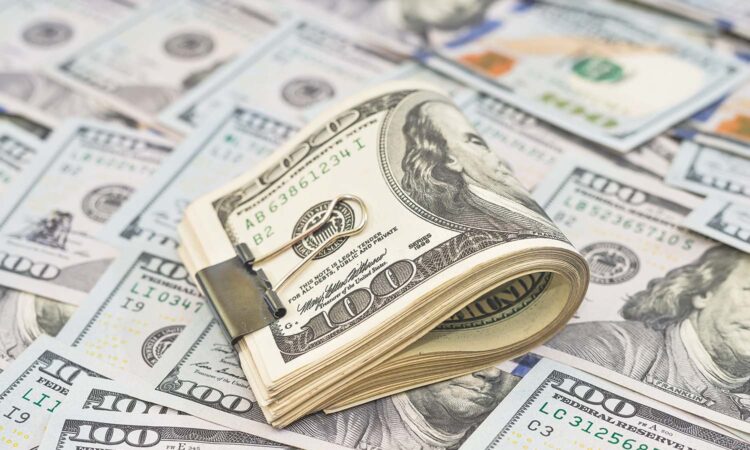
The Nepali rupee recorded an all-time low, with Nepal’s central bank fixing the exchange rate at Rs134.15 per US dollar for Friday.
The Nepali currency was weakened by 31 paisa against the dollar in a single day. The rupee’s fall is attributed to a steady depreciation of the Indian rupee, to which it is pegged.
Experts say Nepal, an import-driven economy, may see a sharp rise in inflation due to the dollar’s strength, as almost all goods and services are quoted in dollar terms.
Commodities like edible oil, petroleum fuel, and foods are priced in dollars globally, so a stronger dollar adds to the cost of Nepali consumers.
As food expenditures make up large shares of consumption, the constant weakening of the local currency makes the goods dearer in Nepal.
Traders say apparel prices may rise in the upcoming festival season as they have started to place orders.
Kumar Karki, president of the Nepal National Traders’ Federation, said the rising dollar may make goods, particularly apparel and electronics, more expensive during the Dashain and Tihar festivals.
According to estimates, sales of food and non-food items surge manifold during the festival period.
Traders have already started visiting China to place orders, especially for goods to be imported for festival sales in October, said Karki. Most festival goods, such as readymade clothes, shoes, bags, and accessories, are imported from China.
According to media reports, the dollar strengthened as the Swiss National Bank delivered an interest-rate cut, underscoring the divergence in monetary policies among global central banks as the US Federal Reserve delayed easing policy.
In India, the central bank has allowed the rupee to weaken, though it intervenes to curb wild swings.
Nepali currency automatically strengthens when the Indian currency is strong and weakens when the Indian currency weakens. Nepal has been following a pegged exchange rate system with the Indian rupee.
Nepal adopts a different kind of exchange rate system for other convertible currencies.
In line with the economic liberalisation policy introduced in the mid-1980s, Nepal introduced current account convertibility in 1993, effectively pegging the Nepali rupee to the Indian rupee at the rate of 1.60, the same rate as in 1960 when the two currencies were first pegged.
Since 1993, the exchange rate of the Nepali rupee with other convertible currencies has been market-determined in line with the exchange rate of the Indian rupee with convertible currencies.
A strong US dollar has both advantages and disadvantages for a country like Nepal. It benefits some but negatively impacts others.
According to Nara Bahadur Thapa, former executive director of Nepal Rastra Bank, the depreciation of the domestic currency could exert pressure on the balance of payments as Nepal would have to spend more money to buy foreign goods.
According to him, the depreciation of the domestic currency is likely to worsen inflation, as the country is highly dependent on imported goods and has low domestic output.
“The currency’s devaluation makes exports cheaper, measured in foreign currency, and imports become more expensive, measured in the home currency.”
The price effect may lead the goods and services sector of Nepal to weaken, said Karki.
According to Nepal Rastra Bank, the country’s central bank, in the first ten months of the current fiscal year, merchandise exports decreased by 3.6 percent to Rs126.17 billion.
However, merchandise imports amounted to a staggering Rs1.30 trillion in the review period.
The most significant impact will be on purchasing petroleum products, Nepal’s biggest import, on which the country is fully dependent.
It will also impact the cost of chemical fertiliser.
On the other hand, the appreciation of the US dollar can benefit remittance earners. Remittance inflows increased 19.2 percent to Rs1.19 trillion in the review period.
Another advantage will be on the foreign exchange reserve, according to experts.
Those countries with ample reserves may sell foreign exchange to bolster their currencies. Nepal’s gross foreign exchange reserves increased to a record $14.54 billion in mid-May.
Similarly, a soaring US dollar means tourists can buy more of the Nepali currency. Visitors from abroad will find the prices of goods and services in Nepal cheaper with a stronger dollar.
Travel income, the money spent by foreigners, increased 35 percent to Rs69.41 billion in the first ten months of the current fiscal year.
The strong dollar increases the burden of debt repayment in local currency terms.
Thus, as the dollar becomes stronger relative to other currencies, these repayments become more expensive in terms of the domestic currency.
The price of gold also increases in the local market when the dollar rises.
The Nepali currency vis-à-vis the US dollar depreciated 1.61 percent in mid-May 2024 from mid-July 2023, while it had depreciated 2.79 percent in the same period of the previous year.
